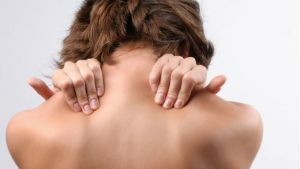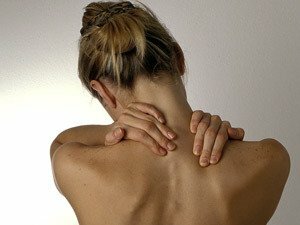 Recently, more and more often you hear about such a disease as cervical osteochondrosis.
Recently, more and more often you hear about such a disease as cervical osteochondrosis.
Its main symptoms - pain in the head and neck, dizziness, fainting, numbness of the upper limbs - are very unpleasant and can cause a lot of problems.
They arise due to degenerative changes in the intervertebral discs, which entail the defeat of the muscular tissues, vessels and nerves of the cervical collar zone.
The cause of cervical osteochondrosis can be and excess weight, and heavy physical stress, and spinal injuries. However, most often the disease occurs as a result of a sedentary lifestyle.
If you also add a regular finding in an asymmetric pose, the probability of osteochondrosis increases several times.
Cervical osteochondrosis is a complex disease that requires long and systematic treatment. In addition, it should be comprehensive, as it will have to eliminate several causes at once.
However, among all the methods of treatment and prevention the most effective and affordable is self-massage. It improves blood circulation in the neck, eliminates symptoms well and slows the progression of the disease.
Contents of the article
- Features of
- self-massage Therapeutic effect
- Methods of action
- Self-massage technique
- Contraindications and cautions
- Conclusion simple
Features of
self-massage The treatment of osteochondrosis is divided into several stages.
First get rid of the pain syndrome, dizziness and other symptoms. Then they stimulate the regenerative processes, which must stop the destruction of the cartilaginous tissue.
At each of these stages, complex treatment is used - taking medications and manual procedures are always used together.
Self-massage is a therapy that can really relieve the cervical osteochondrosis.
It is known that it has not only pronounced, but also lasting effect: after several procedures the symptoms of the disease disappear for 2-3 months.
In addition, regular massage slows the progression of the disease and improves the condition of the cervical spine.
Therapeutic effect of
Manual therapy produces such an effect:
- small arteries expand;

- improves the work of vessels;
- increases the volume and tone of muscles;
- restored joint function;
- increases the performance of muscle tissue;
- improves blood circulation;
- accelerates the regeneration process and improves the conductivity of nerve fibers.
As a rule, self-massage is performed every day, following a special wellness course, which takes about two weeks.
Then a little break is done. In total, 3-4 massage courses are recommended for a year.
These include lymph nodes, carotid arteries protruding the vertebrae of the neck. If the necessary knowledge is not, it is better to practice with an experienced specialist.
Methods of Exposure
When conducting manual therapy, several methods of exposure are used:
- Stroking .The main purpose of this method is to warm up and prepare the muscles for other types of exposure. Movements are made with an open palm without strong pressure.
- Squeezing is a more intense way of massage. At the time of his use of phalanges of the thumb or the edge of the palm.
- Rubbing .The essence of the method is to massage the fingertips of certain areas. Sometimes tiny tingle is made to stimulate blood circulation.
- Mashing is the strongest type of massage in terms of impact. Produced slowly by a relatively strong pressure on the skin and muscles.
You can perform self-massage with one or both hands on your feet or sitting in a chair.
The head during procedures should look straight.
Each exercise should be carried out along special sections. For the back side of the cervical department, massage is usually done from the occiput to the zone of the scapula. The front of the neck is massaged from the chin down to the clavicles.
In addition, it is important to know how to properly measure the load. Here you need to adhere to a simple rule: the stronger the clicks, the fewer times you can do the exercise. The most powerful effect is not recommended to be repeated more than three times.
Self-massage technique
In the treatment of osteochondrosis, massage is prescribed for both the anterior and posterior parts of the neck. It is advisable to start the procedures on the back of the cervical region.
Self-massage of the back of the neck with osteochondrosis:
- Squeezing .Press the edge of the palm to the neck and move from the bottom up. When you reach the hair, go down to the shoulder area.

- Rubbing .Circular movements with your fingertips rub the neck from one ear to the other. Then repeat the same movements from the roots of the hair to the forearms. The main thing, in any case, do not massage the vertebrae - only the muscles.
- Fusing .With your thumb and forefinger lightly nibble your neck muscles. Act first from the bottom up, and then vice versa.
- Stroking of the .Attach both arms to the neck and stroke from the back of the head to the shoulders.
Massage of the front part:
- Stroking .The back of the palm is applied to the neck in the region of the lower jaw and move to the sternum. Stroking should be soft and pleasant.
- Rubbing .Rubbing the muscles of your chest with circular movements of your fingers. Be careful not to touch the lymph nodes.
- Mashing .Fold the thumb and index finger and a little pinching the skin move from the edge of the ear to the shoulder.
Despite the high efficiency of self-massage in the fight against osteochondrosis, it should be used in conjunction with other treatments( swimming, acupuncture and others).
In this case, the result will come much faster, and the disease will not bother for a long time.
The video describes in detail the self-massage technique for cervical osteochondrosis:
Contraindications and cautions
Unfortunately, self-massage of the neck can not always be used. Some injuries and illnesses react strongly to manual therapy, so they require special treatment.
Procedures are contraindicated in:
- heart and vascular disease;
- bleeding;
- purulent diseases;
- trauma to the cervical spine;
- blood diseases;
- varicose veins;
- open tuberculosis;
- benign or malignant tumors;
- skin diseases;
- overwork;
- pregnancy;
- strong physical exertion.
Conclusion simple
 Self-massage neck - effective, but not quite a simple procedure. However, once you learn how to do it, it will come in handy for life.
Self-massage neck - effective, but not quite a simple procedure. However, once you learn how to do it, it will come in handy for life.
It is enough to massage one of your evening or morning procedures - and after 5-6 sessions you can feel a great relief.
In addition to manual therapy and medical treatment, it is necessary to perform gymnastics and exercises, adhere to a diet and lead a healthy lifestyle.
It is recommended to eat foods rich in calcium and amino acids, limit physical activity and constantly do neck muscles. Only comprehensive treatment and regular prevention can overcome the disease.



